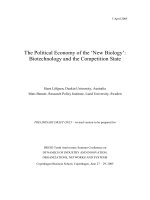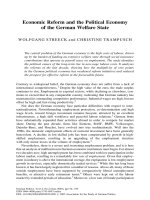political economy of international trade
Bạn đang xem bản rút gọn của tài liệu. Xem và tải ngay bản đầy đủ của tài liệu tại đây (565.73 KB, 30 trang )
Political Economy Of
International Trade
5-2
Case: Agricultural subsidies and
development
Rich nations spend more than $300 billion a
year to subsidize their farmers
Subsidies create surplus production
Surplus production leads to dumping and
depressed prices
UN estimates producers in developing nations
lose $50 billion export revenue because of
depressed prices
5-3
Agricultural subsidies and development
Rich countries of the developed world
subsidize farm products
Reasons
To keep commodity prices low
To favor politically active farmers
Consequences
Surplus production
Depressed world prices (a result of surplus)
5-4
Instruments of trade policy
Tariffs - oldest form of trade policy
Specific
Ad valorem
Good for government
Protects domestic producers
Reduces efficiency
Bad for consumers
Increases cost of goods
5-5
Instruments of trade policy-subsidies
Government payment to a domestic producer
Cash grants
Low-interest loans
Tax breaks
Government equity participation in the company
Subsidy revenues are generated from taxes
Subsidies encourage over-production,
inefficiency and reduced trade
5-6
Instruments of trade policy - Quota
Import quota
Restriction on the quantity of some good
imported into a country
Voluntary export restraint (VER)
Quota on trade imposed by exporting country,
typically at the request of the importing country
5-7
Instruments of trade policy -Quota
Benefits producers by limiting import
competition
Japan – limited exports to 1.85 mm vehicles/year
Cost to consumers - $1B/year between ‘81 - 85.
Money went to Japanese producers in the form
of higher prices
Encourages strategic action by firms in order to
circumvent quota
5-8
Instruments of trade policy- local content
Requires some specific fraction of a good to be
produced domestically
Percent of component parts
Percent of the value of the good
Initially used by developing countries to help shift
from assembly to production of goods.
Developed countries (US) beginning to implement.
For component parts manufacturer, LC Regulations
acts the same as an import quota
Benefits producers, not consumers
5-9
Instruments of trade policy-administrative
policies
Bureaucratic rules designed to make it
difficult for imports to enter a country.
Japanese ‘masters’ in imposing rules.
5-
10
Instruments of trade policy-anti dumping
policies
Defined as
Selling goods in a foreign market below
production costs
Selling goods in a foreign market below fair
market value
Result of
Unloading excess production.
Predatory behavior
Remedy: seek imposition of tariffs
5-
11
Political arguments for intervention
Protecting jobs and industries
Common Agricultural Policy (Europe) and VER
National security
Defense industries - semiconductors
Retaliation
Punitive sanctions
5-
12
Political arguments for intervention
Protecting consumers
Genetically engineered seeds and crops
Hormone treated beef
Protecting human rights
MFN
5-
13
Economic arguments for intervention
Infant industry.
Oldest argument - Alexander Hamilton, 1792
Protected under the WTO
Only good if it makes the industry efficient.
Brazil auto-makers - 10th largest - wilted when
protection eliminated
Requires government financial assistance.
Today if the industry is a good investment, global
capital markets would invest
5-
14
Economic arguments for intervention
Strategic trade policy
Government should use subsidies to protect
promising firms in newly emerging industries
with substantial scale economies
Governments benefit if they support domestic
firms to overcome barriers to entry created by
existing foreign firms
5-
15
Development of the world trading system
GATT -multilateral agreement established
under US leadership1948
Objective is to liberalize trade by eliminating
tariffs, subsidies, & import quotas
19 original members grew to 120
5-
16
Development of the world trading system
Used ‘Rounds of talks’ to gradually reduce
trade barriers
Uruguay Round GATT 1986-93
Mutual tariff reductions negotiated
Dispute resolution only if complaints were
received
5-
17
Disturbing trends in the world trading
system
Pressure for greater protectionism due to
Increase in the power of Japan’s economic
machine and closed Japanese markets
US trade deficit
GATT circumvented by many countries
Through use of VER
5-
18
GATT criticisms
Economic theories don’t fit the ‘real world’
model
US global preeminence has declined
Shift from cutting tariffs to eliminating non-
tariff barriers angered countries
‘National Treatment’ or ‘Most Favored
Nation’ status results in inequalities
5-
19
The World Trade Organization
The WTO was created during the Uruguay Round of
GATT to police and enforce GATT rules
Most comprehensive trade agreement in history
Formation of WTO had an impact on
Agriculture subsidies (stumbling block: US/EU)
Applied GATT rules to services and intellectual
property (TRIPS)
Strengthened GATT monitoring and
enforcement
5-
20
The WTO
145 members in 2003
Represents 90% of world trade
9 of 10 disputes satisfactorily settled
Tariff reduction from 40% to 5%
Trade volume of manufactured goods has
increased 20 times
5-
21
The WTO
Policing organization for:
GATT
Services
Intellectual property
Responsibility for trade arbitration:
Reports adopted unless specifically rejected
After appeal, failure to comply can result in
compensation to injured country or trade
sanctions
5-
22
WTO at work
280 disputes brought to WTO between 1995
and 2003
196 handled by GATT during its 50 year
history
US is biggest WTO user
5-
23
The WTO -achievements
Telecommunications (1997)
68 countries (90%) of world telecommunications
revenues
Pledged to open their market to fair competition
Financial Services (1997)
95% of financial services market
102 countries will open, their markets to varying
degrees
5-
24
WTO in Seattle
Millennium round was aimed at further
reduction of trade barriers in agriculture and
services
WTO meeting disrupted by
Human rights groups
Trade unions
Environmentalists
Anti globalization groups
No agreement was reached
5-
25
Doha agenda -WTO
Cutting tariffs on industrial goods and
services
Phasing out subsidies
Reducing antidumping laws
WTO regulation on intellectual property
should not prevent members from protecting
public health
TRIPS agreement









